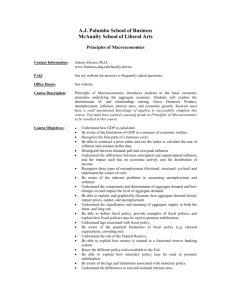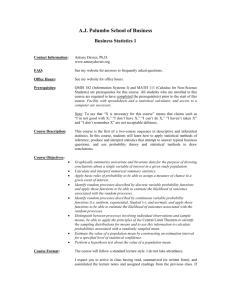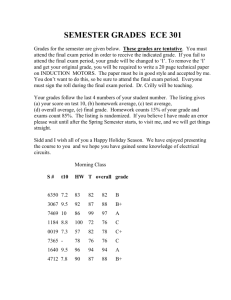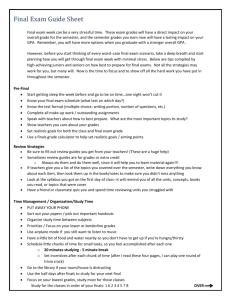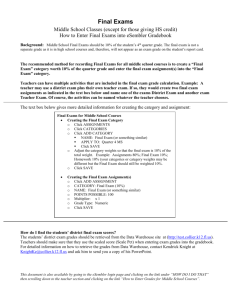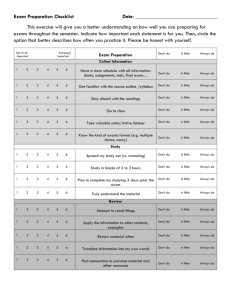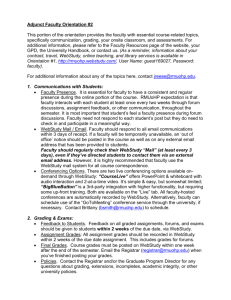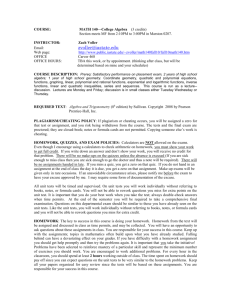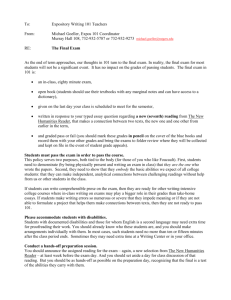Principles of Microeconomics
advertisement
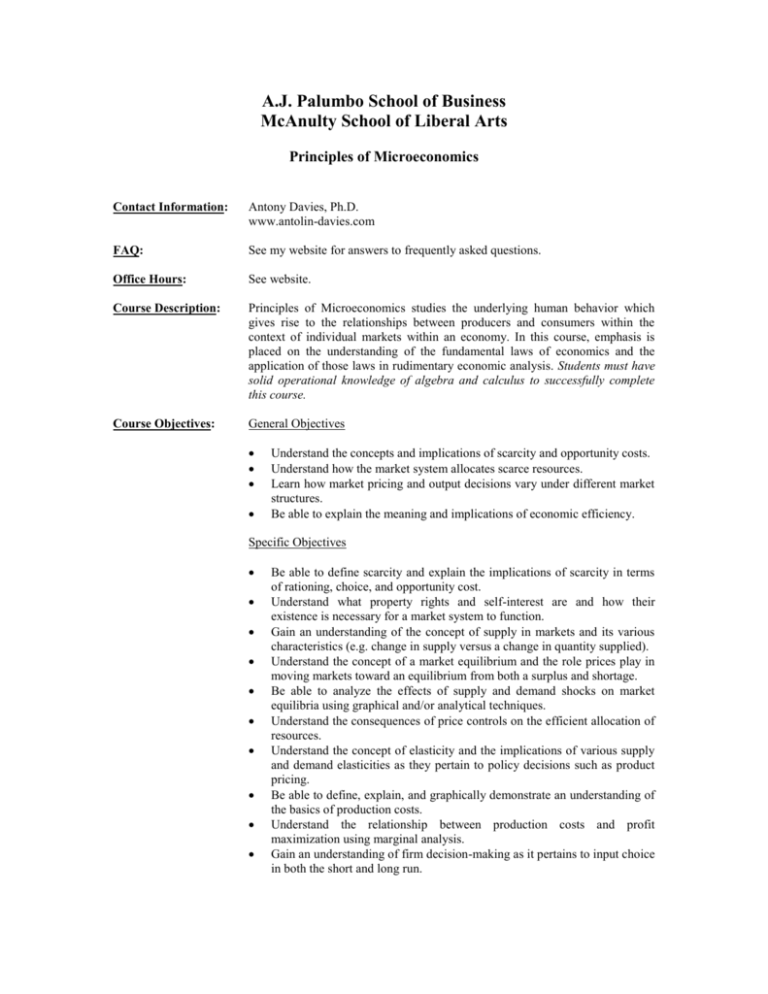
A.J. Palumbo School of Business McAnulty School of Liberal Arts Principles of Microeconomics Contact Information: Antony Davies, Ph.D. www.antolin-davies.com FAQ: See my website for answers to frequently asked questions. Office Hours: See website. Course Description: Principles of Microeconomics studies the underlying human behavior which gives rise to the relationships between producers and consumers within the context of individual markets within an economy. In this course, emphasis is placed on the understanding of the fundamental laws of economics and the application of those laws in rudimentary economic analysis. Students must have solid operational knowledge of algebra and calculus to successfully complete this course. Course Objectives: General Objectives Understand the concepts and implications of scarcity and opportunity costs. Understand how the market system allocates scarce resources. Learn how market pricing and output decisions vary under different market structures. Be able to explain the meaning and implications of economic efficiency. Specific Objectives Be able to define scarcity and explain the implications of scarcity in terms of rationing, choice, and opportunity cost. Understand what property rights and self-interest are and how their existence is necessary for a market system to function. Gain an understanding of the concept of supply in markets and its various characteristics (e.g. change in supply versus a change in quantity supplied). Understand the concept of a market equilibrium and the role prices play in moving markets toward an equilibrium from both a surplus and shortage. Be able to analyze the effects of supply and demand shocks on market equilibria using graphical and/or analytical techniques. Understand the consequences of price controls on the efficient allocation of resources. Understand the concept of elasticity and the implications of various supply and demand elasticities as they pertain to policy decisions such as product pricing. Be able to define, explain, and graphically demonstrate an understanding of the basics of production costs. Understand the relationship between production costs and profit maximization using marginal analysis. Gain an understanding of firm decision-making as it pertains to input choice in both the short and long run. Explain the characteristics that define various market structures and the role these characteristics play in industry structure in the short and long run. Understand the sources of monopoly power and its implications for product pricing, levels of production, and the efficient allocation of resources. Understand the fundamentals of factor pricing. Prerequisites: Calculus I is a prerequisite for this course. All students who are enrolled in this course are required to have completed the prerequisite(s) prior to the start of this course. Course Format: The course will follow a standard lecture style. I do not take attendance. I expect you to arrive in class having read, summarized (in written form), and assimilated the lecture notes and assigned readings from the previous class. If you miss a class, it is your responsibility to obtain the relevant notes and assignments from another student. WARNING: If you do not carefully re-read and re-write your lecture notes after every class and keep up with the assigned readings and homework, you will seriously jeopardize your ability to pass this course. Readings: See website for required and recommended readings. Web Materials: You are required to have regular access to an Internet-connected computer. I will regularly post assignments, handouts, answers, and other pertinent materials at the website listed at the top of this page. I expect you to check this site on a daily basis. While I will usually announce homework assignments in class, the website is the official venue for announcing assignments. To access materials for this course, go to the website and click on Course Materials, then Principles of Microeconomics. Lecture Notes: It is your responsibility to take notes during my lectures. If you miss a class, it is your responsibility to obtain a copy of the lecture notes from another student. I do not provide copies of my lecture notes or copies of power point slides. Grading: Your grade for the course derives from four sources (weights are shown in parentheses): two non-cumulative exams (25%), one cumulative mid-term exam (30%), one cumulative final exam (30%), and homework/participation (15%). The percentage grades required for each letter grade are: 93% 90% 86% 83% A AB+ B 80% 76% 70% 65% BC+ C D For those students who find themselves at the border between grade levels, I do round off course grades to the closest whole percentage, but I do not give partial points to bump students to the next grade level. Please regard the above percentage grades as the minimums acceptable for each letter grade. Based on past student performance, the probability of a student obtaining a given grade in this course is as follows: Probability of earning A or AProbability of earning B-, B, or B+ Probability of earning C+ or C Probability of earning D or F 10% 20% 40% 30% Students will receive grades in a timely fashion. Students are expected to keep track of their own grades throughout the semester. I report final course grades only to the registrar. A student who wishes to question my grading of a particular exam must do so in a timely fashion. With the exception of mathematical error on my part, I shall not alter exam grades after I have computed course grades. Non-Cumulative Exams: See Calendar of Events on my website for the exam schedule. Non-Cumulative Exams will be composed of multiple-choice, singleanswer, essay, and/or problem style questions. Material for the exams will come from all lectures and assigned readings covered since the previous exam. A student who misses the exam without valid cause (see definition below) or preapproval from me receives a zero for the exam. WARNING: I do not give make-up exams. The exam schedule appears below. I expect you to adjust your schedule appropriately. If you miss an exam without valid cause (see definition below) or without pre-approval from me, you will receive a zero for that exam. If you miss an exam with valid cause or preapproval, you will not receive a make-up exam. The remaining non-cumulative exam will count for both non-cumulative exams. Mid-Term Exam: See Calendar of Events on my website for the exam schedule. The Mid-Term Exam will be composed of multiple-choice, singleanswer, essay, and/or problem style questions. Material for the exam will come from all lectures and assigned readings covered since the beginning of the semester. A student who misses the exam without valid cause (see definition below) or pre-approval from me receives a zero for the exam. Final Exam: See Calendar of Events on my website for the exam schedule. The Final Exam will be composed of multiple-choice questions. Material for the exam will come from all lectures and assigned readings covered since the beginning of the semester. A student who misses the exam without valid cause (see definition below) or pre-approval from me receives a zero for the exam. Valid Cause for Missing An Exam: A cause is considered valid if (1) the cause for missing the exam is an emergency that prevents you from attending the exam, and (2) the nature of the emergency precludes your attaining pre-approval for the absence. WARNING: Because the calendar of events (see web site) is given to you at the beginning of the semester, travel arrangements will not be considered valid cause for missing an exam. Participation and Homework: Participation includes class discussion, discussion outside of class hours (including e-mail), and completing homework assignments. Class discussion includes both asking pertinent questions and providing insightful comments. Students who are reluctant to ask questions in class can obtain participation points by participating in discussion outside of class either in person or via e-mail. The Safety Net: It is a fact of life that different students learn at different rates. It is also the case that, on average, students must spend a tremendous amount of effort studying economics before they begin to see a pay-off in terms of improved exam performance. My goal in evaluating your performance in this course is not to measure the rate at which you learn, but to measure the total body of knowledge you have gained throughout the semester. To this end, because the final exam is cumulative, if the grade you earn on the final exam exceeds your course grade (as calculated above), I shall replace your course grade with your final exam grade. Warning: The safety net does not apply to students who miss more than two exams. Academic Integrity: Because the value of a degree lies in the reputation of the school which issued the degree, academic dishonesty on the part of one student devalues the degrees of all students: past, present, and future. In defense of these students, I deal most stringently with violations of academic integrity. A student who plagiarizes but admits the plagiary to me prior to my discovering it is guilty of a non-reprehensible violation of academic integrity. Such a student will receive a failing grade for the exam or assignment and no further penalty. A student who plagiarizes but does not admit the plagiary prior to my discovering it is guilty of a reprehensible violation of academic integrity. Such a student will immediately be excused from the course and will receive a failing grade for the course. In the case of a reprehensible violation, I shall also file a formal report of the incident with the Academic Dean. Plagiarism is defined as “The use, whether by summary, paraphrase, or direct quotation of the published or unpublished work or specific ideas of another person without full and clear acknowledgment. It also includes the use of materials prepared by another person or agency engaged in the selling or distribution of term papers or other academic materials.” Disabilities: Students with disabilities who require accommodations in fulfilling the requirements for this course should notify me during the first week of class and provide me with a copy of their certifying letters. The certifying letter can be obtained from the Office of Disabled Student Services. Calendar: See my website for a detailed listing of projected dates on which various topics will be covered.
